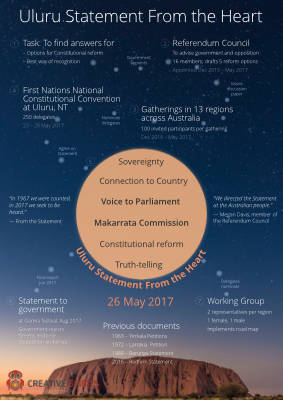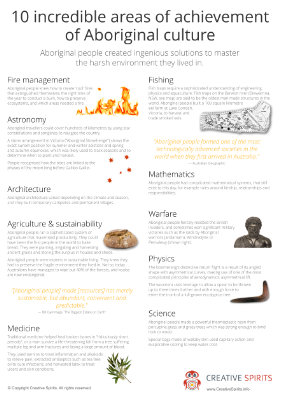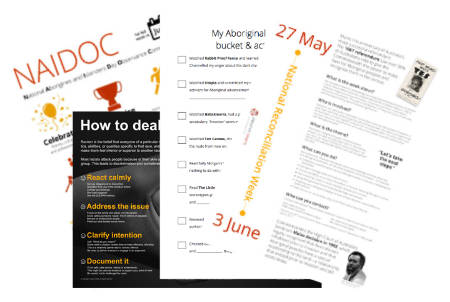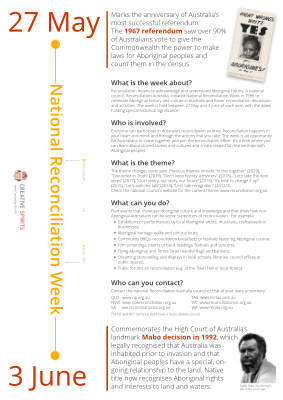Teacher & student resources
Find Aboriginal teaching resources for classroom activities. Use them as teaching tools, for assignments, and uni, high or primary school studies.
Aboriginal Culture Essentials – The resource you've been looking for
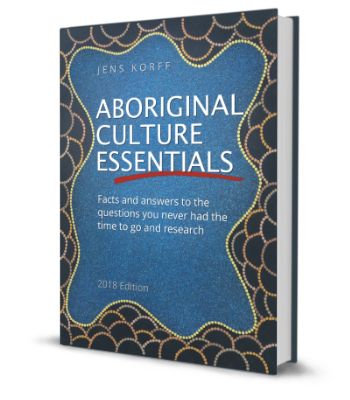
Many resources about Aboriginal culture are too long or outdated. Not this ebook.
Aboriginal Culture Essentials gives you key foundational knowledge about contemporary Aboriginal culture in a fun and engaging way.
It is no ordinary resource, it offers a fictional story, quizzes, crosswords and even a treasure hunt.
The e-book also includes a free list of significant Aboriginal days and a table with references to the Australian Curriculum.
A library licence is also available.
Stop feeling bad about not knowing. Make it fun to know better.
Infographics
Infographics visually represent information and data concise, quickly and clearly. They express complex messages for easy comprehension. Infographics are a blend of arts, statistics, information and design, and tell a story.
Teachers can use infographics to keep students' attention in difficult lessons with an engaging and eye-catching experience. Students save time with infographics as compared to studying traditional articles.
The vast majority of students, teachers, and parents believe technology helps students’ abilities to learn and want it to play a bigger role in classrooms.
Explainer: Uluru Statement From the Heart

10 Incredible Areas of Achievement of Aboriginal Culture

NAIDOC Week bundle

National Reconciliation Week

Browse all Aboriginal infographics
Aboriginal books
Despite new media competing for students' attention books are still a good option for teaching and learning. They support novice teachers by taking them through organised units and structured information. It's a good idea to mix other resources with books.
Choose your Aboriginal textbooks carefully. Non-Aboriginal authors can have an agenda or be influenced by outdated ideas and stereotypes. I recommend using Aboriginal authors and consulting with Aboriginal teachers before deciding which books to buy.
Recently added books
The Wonder of Little Things

William Cooper: An Aboriginal Life Story
The First Astronomers
White Fragility : Why It's So Hard for White People to Talk About Racism
Looking After Country with Fire
The Dreaming Path: Indigenous Thinking to Change Your Life
Aboriginal movies
Aboriginal films can be an engaging medium for students to learn about contemporary and traditional Aboriginal issues. If you don’t have time for a feature film there are plenty of shorts to choose from.
Be aware of the time the film was shot—those influenced by the White Australia policy need more explanations, for example for the use of blackface and why no Aboriginal actors were used.
It is also interesting to investigate how different - or alike - similar Aboriginal topics are covered in films by Aboriginal directors versus non-Aboriginal directors.
Recently added films
Aboriginal music
Far from being only traditional, contemporary Aboriginal music covers all genres: pop (for example Jimmy Little), rock (Yothu Yindi), country (Troy Cassar-Daley, rap (NoKTuRNL) and alternative (Warumpi Band).
Students can explore the inner world of Aboriginal people by listening to their music and stories. Music can be a good link to texts and Aboriginal poetry, and to connect to the singer's emotional world.
An increasing number of Aboriginal musicians sing in their traditional Aboriginal language (Gurrumul Yunupingu is well-known), adding a layer of complexity for exploration.
Recently added albums
Browse all Aboriginal musicians
Television & radio
You'll be surprised how many Aboriginal stations broadcast into their communities. Read also about Australia's only Aboriginal TV station, NITV.
Aboriginal newspapers & magazines
There is no better way than to read the view of the 'other' side. Check out Aboriginal newspapers, both online and paper.
Browse Aboriginal newspapers and magazines
Newsletters
Stay up-to-date with Aboriginal issues and affairs by subscribing to a newsletter or getting news clippings with Aboriginal relevance directly into your inbox.
Photography
Looking for photographs of Aboriginal people? Try these photographers:
- Gary Radler has some superb photos of Aboriginal people – women, men and children. You can purchase private and commercial licenses on his site.
- Rusty Stewart is often credited for photographs of Aboriginal people.
You might also want to contact Aboriginal photographers.
Teaching with Aboriginal resources
Teaching Aboriginal studies is especially difficult if you are non-Aboriginal. Very little in your education or experience has prepared you for an in-depth knowledge of Aboriginal peoples and cultures. Much of your knowledge about Aboriginal people is too often derived from popular myths or from a media which sensationalises, distorts or omits Aboriginal issues.
Your Aboriginal study materials should have a contemporary focus, yet too many people still think in 'traditional' terms, e.g. "a half-naked man performing a corroboree," which perpetuates those exotic and dated stereotypes inherited from a colonial past.
The resources and support materials for Aboriginal studies you select must value the diversity of Aboriginal cultures. They should recognise contemporary Aboriginal input, the cultural diversity of Aboriginal communities and present them as living, dynamic and changing cultures. Avoid older resources (before the 1990s) that contain text that is demeaning to Aboriginal people and their cultures or perpetuate the 'other' and traditional view.
When you decide which resources to use, do the following checks:
Authenticity
Is the material accurate: truthful, exact and free from error?
Before 1990 a lot of materials produced contained stereotyped and generalised information about Aboriginal people. Since then there are numerous resources and materials available which were written by, or in consultation with, Aboriginal people.
These contemporary resources contain information about particular groups or communities and reinforce the diversity and complexity of Aboriginal life. They convey a more authentic and accurate view of Aboriginal peoples and their cultures.
Balance
Does the material refer to Australian history as a shared history?
Resources and support materials for Aboriginal studies must value the diversity of Aboriginal cultures. They should give voice to Aboriginal opinions and points of view besides those of non-Aboriginal people.
There should not be any judgement of viewpoints, however subtle, and if there is it should be pointed out as a learning exercise (e.g. when discussing media sources).
Aboriginal participation
Have Aboriginal people participated in the development of the materials or reviewed and approved them?
It is important that materials and resources recognise contemporary Aboriginal input as a vital part of presenting Aboriginal culture and the cultural diversity of Aboriginal communities. Ideally a short biography of contributors acknowledges the status in their community and the authority that qualifies them to speak.
Be aware of resources, including recent publications, which make little or no reference to Aboriginal peoples, their perspectives and contributions. Simplistic information can be misleading. Teaching students to recognise such issues when using resources is crucial to developing critical skills.
Accuracy and support
Does the material use appropriate terminology? Has it been endorsed by Aboriginal education or community groups?
Some Aboriginal people may be upset if a resource includes material of a secret or sacred nature, which is not intended for public knowledge. This can include images of ceremonies, artwork, and names and photographs of people who are now deceased.
Consult with the local Aboriginal community to ensure you are using appropriate resources.
External resources to help you teach
Here are a few links to online resources that can help you gain a deeper knowledge and prepare lessons or assignments:
- Respect Relationships Reconciliation (3Rs) provides study resources designed to support teacher educators incorporate Aboriginal content in initial teacher education (ITE) courses. It helps with strategies for teaching and understanding Aboriginal people. See rrr.edu.au for more details.
- Kinship online learning module videos provide you with a deeper understanding of the richly complex Aboriginal kinship system by learning about the components of moiety, totem, skin names, language and traditional affiliations and individual identity. Provided by the University of Sydney.
- Indigenous Cultural Learning is a 30-minute online learning module by ANZ that introduces you to Aboriginal culture. View the module.
- Classpert is a free search engine for online courses, listing offers from services such as Udemy, Coursera, EdX and others. Check Classpert for Aboriginal courses.
Know another one? Let me know!
